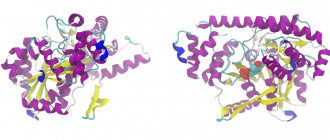With the development of modern technologies, doctors have the opportunity to identify and cure various diseases. This is especially true for women who want to become mothers. Before the rapid development of technological progress, childbirth, like pregnancy itself, was something like Russian roulette: lucky or unlucky.
Therefore, a large number of mothers and babies died. Polyhydramnios is considered one of the common diseases during pregnancy. Today, this syndrome threatens a quarter of expectant mothers. Therefore, constant monitoring by a gynecologist is very desirable.
How to determine polyhydramnios during pregnancy?
As you know, the fetus developing in the mother’s womb is not fixed in the uterus, but seems to float in the amniotic fluid (amniotic fluid). They help him freely change position and be protected from mechanical influences from the outside. Also, amniotic fluid is important for the metabolism of the fetus and so that the umbilical cord, which ensures the supply of vital elements from the mother, is not compressed.
IMPORTANT: Obstetricians-gynecologists have calculated the norm of amniotic fluid - this is approximately 1500 ml closer to childbirth (at 37 - 38 weeks). At other stages of pregnancy, the indicators, of course, are different. So, at week 10 – the norm of amniotic fluid is 20 ml, at week 14 – 100 ml, etc.
When the normal volume of amniotic fluid, characteristic for each specific stage of pregnancy, is exceeded, they speak of polyhydramnios.
In the uterus, the fetus literally floats in amniotic fluid. Normally it is about 1.5 liters.
Polyhydramnios is diagnosed as a pathological condition, fraught with many unpleasant consequences for both the expectant mother and the fetus. Polyhydramnios is determined based on the clinical symptoms of the disease, data from clinical studies and examination of the woman by a doctor. There are polyhydramnios:
- moderate
- acute
- chronic
Each of these forms has its own characteristics, signs and consequences.
Diagnostics
Diagnosis of polyhydramnios includes a physical examination and additional research methods:
Physical examination
When measuring the abdominal circumference and the height of the uterine fundus, their significant sizes are determined, exceeding the indicators characteristic of a given stage of pregnancy. This becomes especially noticeable with regular monitoring of a pregnant woman. Palpation of the uterus reveals its tension and excessive mobility of the embryo.
Table: height of the uterine fundus and abdominal circumference by week of pregnancy
When listening to the fetal heartbeat, muffled or dull heart sounds are detected.
In the case of a vaginal examination of a woman in labor, a tense amniotic sac can be detected even outside of contractions.
Instrumental examination
The “gold standard” for determining the amount of amniotic fluid is calculating the amniotic fluid index (AFI) during ultrasound.
Polyhydramnios is diagnosed when the AFI increases and the size of the largest pocket of amniotic fluid is 8 cm or higher. However, ultrasound should be performed dynamically (repeatedly).
Norms of amniotic fluid index by week
- 16 weeks – 73-201mm (average 121mm);
- 17 weeks – 77-211mm (average 127mm);
- 18 weeks – 80-220mm (average 133mm);
- 19 weeks – 83-230mm (average 137mm);
- 20 weeks – 86-230mm (average 141mm);
- 21 weeks – 88-233mm (average 143mm);
- 22 weeks – 89-235mm (average 145mm);
- 23 weeks – 90-237mm (average 146mm);
- 24 weeks – 90-238mm (average 147mm);
- 25 weeks – 89-240mm (average 147mm);
- 26 weeks – 89-242mm (average 147mm);
- 27 weeks – 85-245mm (average 156mm);
- 28 weeks – 86-249mm (average 146mm);
- 29 weeks – 84-254mm (average 145mm);
- 30 weeks – 82-258mm (average 145mm);
- 31 weeks – 79-263mm (average 144mm);
- 32 weeks – 77-269mm (average 144mm);
- 33 weeks – 74-274mm (average 143mm);
- 34 weeks – 72-278mm (average 142mm);
- 35 weeks – 70-279mm (average 140mm);
- 36 weeks – 68-279mm (average 138mm);
- 37 weeks – 66-275mm (average 135mm);
- 38 weeks – 65-269mm (average 132mm);
- 39 weeks – 64-255mm (average 127mm);
- 40 weeks – 63-240mm (average 123mm);
- 41 weeks – 63-216mm (average 116mm);
- 42 weeks – 63-192mm (average 110mm).
Lab tests
Laboratory research methods are additionally prescribed
- blood for Rh factor and antibodies,
- blood sugar test (to exclude gestational diabetes mellitus),
- PCR for identifying pathogens of TORCH infections.
Cardiotocography (CTG) and Doppler
To assess the condition of the fetus, cardiotocography (instrumental listening to the fetal heartbeat) and Doppler ultrasound (study of blood flow in the fetal, umbilical and uterine vessels) are performed.
Signs of polyhydramnios during pregnancy
Often, pregnant women may feel various kinds of discomfort and unpleasant sensations, and the doctor observing the pregnant woman may attribute some of them to symptoms of polyhydramnios. This will mean the need for further research to confirm the diagnosis and further treatment.
Polyhydramnios affects the well-being of a pregnant woman.
With polyhydramnios there are:
- abdominal pain, feeling of heaviness
- pressure on the diaphragm, and, as a result, shortness of breath
- severe swelling of the lower extremities
- a distinct sensation when pressing on the abdomen, that whatever is there is squelching
- disturbances in heart rhythm, its increase
- the uterus is enlarged in size, disproportionate to the period
- weakness and constant malaise of the pregnant woman
- obvious swelling of the lower abdomen
- stretch marks, increased number of stretch marks
A large belly and stretch marks are indirect signs of polyhydramnios.
In the last weeks of pregnancy, the uterus is constantly tense, enlarged beyond normal, and the fetus is restless. There is a threat of premature birth.
Moderate form
Moderate polyhydramnios does not always mean pathology. Attention is drawn to the existing differences in the baby’s respiratory and excretory systems. At week 33, water volume indicators remain the same. During a routine ultrasound or examination, a specialist may note the presence of polyhydramnios.
Excess fluid is diagnosed in small quantities. There are no external changes in the woman and no discomfort. There is a deviation from the norm, but it is insignificant ; there is a chance to carry the child to full term and give birth independently.
Despite such a positive prognosis for delivery, the pathology leaves an unfavorable imprint on the development of the baby. His nervous system suffers due to changes in blood circulation in the placenta and oxygen microcirculation in the brain.
Polyhydramnios in early pregnancy
- Polyhydramnios usually occurs starting from the 30th week of pregnancy, but it can appear at any stage
- In the early stages of pregnancy (up to 16 weeks), an acute form of polyhydramnios can develop, which can lead to many undesirable consequences for both the mother (up to uterine rupture) and the baby (up to his death)
- The disease progresses rapidly, over a period of several hours to several days.
- There is a sharp increase in the abdomen, swelling and pain in the lower abdomen, the woman finds it difficult to breathe
IMPORTANT: In case of polyhydramnios in the early stages, hospitalization in a hospital is necessary, where doctors will make a decision based on the entire clinical picture about the further fate of this pregnancy. As a rule, it is interrupted
Dynamics of development of amniotic fluid after conception
Polyhydramnios is considered to be an excess of the normal volume of fetal fluid that accumulates in the uterus during pregnancy. The pathology appears in 0.2-1.3 cases during various periods of pregnancy and poses a great danger to the life and health of both mother and child.
In order to isolate and protect the embryo from negative influences from the outside (infectious, mechanical), it is placed in a hermetically sealed “bag” with a liquid that ensures its normal development. Its walls consist of the amniotic and chorionic membranes. 7 days after conception, the entire uterus is filled with the amniotic sac. So the baby is completely safe.
Over time, the embryo develops and grows, and the amount of amniotic fluid increases. It contains water containing all the beneficial substances vital for the child. Initially, the fluid arises from the circulatory system of the female body; later it is also formed by the internal organs of the child (respiratory and urinary systems).
In the first 13 weeks, nutrients from amniotic fluid are absorbed into the baby's body through his skin. Over time, keratin accumulates in them, they become thicker, liquid enters the embryo through the gastrointestinal tract and is excreted naturally in the urine.
Dynamics of development of amniotic fluid:
- 11 weeks – there is 30 ml in the amniotic sac;
- 15 weeks – 100 ml;
- from 36 weeks 1 – 1.5 l.
It is believed that if the amount of amniotic fluid during pregnancy exceeds this norm, then this is polyhydramnios.
These indicators are generally accepted norms. If the volume of fluid becomes more than 15 liters, the gynecologist determines the presence of polyhydramnios. This phenomenon most often occurs in the 2-3 trimester.
Polyhydramnios in the last weeks of pregnancy
In the last stages of pregnancy, polyhydramnios manifests itself in shortness of breath, swelling of the woman’s legs, and a feeling of fatigue and discomfort.
Polyhydramnios is usually discovered towards the end of pregnancy.
A woman must monitor her condition, since polyhydramnios during this period can also have negative consequences:
- Firstly, the fetus, not having found a normal position before birth, may, “flopping” in the womb, become entangled in the umbilical cord, and this is fraught with its hypoxia
- Secondly, it may take an incorrect position before childbirth, which will complicate the course of labor.
- Thirdly, placental insufficiency may occur, which can lead to the fetus not receiving enough nutrients, so its systems may subsequently have developmental defects. The fetal brain will also suffer due to impaired blood circulation
Prevention and treatment
Ideally, therapy is prescribed depending on the identified cause of the pathology. So:
- in case of Rh conflict, immunoglobulins are administered;
- intrauterine infection - antibiotics are prescribed that are approved for women in an interesting position;
- diabetes mellitus – diet and additional therapy to correct sugar levels.
True, due to a third of the unknown causes of pathologies, the question of how to treat polyhydramnios in each specific case is sometimes not even raised, because there is a “universal scheme” to get rid of the problem for sure.
What does it mean? What the expectant mother is prescribed all at once:
- antibiotic therapy with broad-spectrum drugs;
- diet;
- diuretics;
- preparations containing magnesium.
To maintain immunity and improve the general condition of the mother and fetus, vitamin complexes containing vitamins B, C, and E are also prescribed.
As a last resort, at 33–34 weeks, an amniotomy can be performed in case of chronic pathology. This is a procedure in which the bladder is opened to release some of the water. Thus, doctors can protect themselves and the pregnant woman from a rupture, in which the waters recede rapidly, taking with it the umbilical cord or limbs of the baby and jeopardizing his life and health.
In the later stages, at 36–41 weeks, a decision may be made to induce labor.
All these problems can be prevented by planning a pregnancy (this is an examination before conception), undergoing regular examinations, and listening to the doctor’s recommendations.
Why is polyhydramnios dangerous during pregnancy?
Polyhydramnios is a dangerous pathology, so it is better if women know about it and, if symptoms are identified, they will definitely contact a gynecologist for examination. The acute form of polyhydramnios most often ends in termination of pregnancy in order to preserve the woman’s health. With polyhydramnios, a child may develop pathologies of the nervous system or gastrointestinal tract.
IMPORTANT: If the cause of polyhydramnios was an infection in the mother, the baby will also be infected, which may affect its development
For the expectant mother, the danger may be that:
- uterine rupture may occur due to fluid overflow
- during childbirth, the uterus, overfilled with fluid, contracts poorly, labor is weak, so the baby can get stuck in the birth canal, which can result in asphyxia
- Polyhydramnios is fraught with incorrect presentation of the fetus, placental abruption, prolapse of parts of the fetal body, prolapse of the umbilical cord, etc.
- development of gestosis occurs
How to suspect and identify
To answer this question, it should be recalled that there are two stages of polyhydramnios: acute and chronic. Moreover, the signs in both cases are the same, the difference is only in the speed of their manifestation.
In the first case, the amount of amniotic fluid increases sharply and quickly, literally within a day, or even in a matter of hours. The changes are visible to the naked eye, as the woman’s belly is also growing. The situation is aggravated by the appearance of painful sensations in the perineum, lower back, swelling of the abdominal wall, and finally, a sharp increase in pressure, due to which the fetal heartbeat is difficult to hear.
But in the later stages there is no need to worry about this: acute polyhydramnios is most often diagnosed in the first trimester, which cannot be said about chronic polyhydramnios. It is from this that expectant mothers who are pregnant suffer. How is it characterized?
- Slow and gradual increase in water volume.
- As a result, a gradual increase in the size of the abdomen, which a woman may not even pay attention to.
- Less commonly – swelling in the lower extremities, nausea, abdominal pain.
You may also experience:
- weakness;
- deterioration of condition;
- feeling of heaviness in the stomach;
- shortness of breath.
At this time, you can often hear gurgling in the stomach. With polyhydramnios, he himself reaches a volume of 100 - 120 cm. Many stretch marks appear on him.
If you suspect these symptoms in yourself, you should not put off going to the doctor. Simply because the condition is dangerous not only for the mother, but also for the child. But first things first.
What to do if you have polyhydramnios during pregnancy?
Basic recommendations:
- a woman should carefully monitor her condition and, if it worsens, immediately consult a doctor
- Regular visits to the gynecologist for monitoring are also necessary
- do not refuse under any circumstances if there is a need to go to hospital
- carry out all prescribed treatment
If a woman has polyhydramnios, she and the fetus need ultrasound monitoring.
Will traditional methods of treatment help?
Official medicine does not recognize the possibility of treating polyhydramnios using traditional methods. This position is explained by the content of unrefined components in natural ingredients, which can cause various adverse reactions in maternal and child organisms.
They are also not effective enough and do not act selectively on the body. This helps ensure that the necessary time for proper drug therapy passes. It is allowed to use traditional methods of treatment that provoke a diuretic effect and vitamin supplements.
Other methods are strictly prohibited, because they can worsen your well-being.
How to treat polyhydramnios during pregnancy?
Polyhydramnios is treated in a hospital. It includes:
- antibiotic therapy (broad-spectrum antibiotics, such as erythromycin)
- multivitamins
- diuretics
- agents that improve uterine and placental blood flow
- means that improve the condition of the placenta, as well as
- amniocentesis is performed, that is, the slow removal of amniotic fluid
Additionally, the hospital carries out regular monitoring of the woman’s blood pressure, fetal cardiotography and ultrasound and Doppler examinations.
The effect of polyhydramnios on the fetus
Excess amniotic fluid can lead to the following consequences for the fetus:
- fetal death during pregnancy or childbirth (intrauterine hypoxia, termination of pregnancy, umbilical cord strangulation);
- development of pneumopathy (non-infectious lung diseases) due to aspiration syndrome or intrauterine infection;
- low fetal weight at birth (hypotrophy) due to intrauterine growth retardation;
- large fetal size (4 kg or more) as a result of detected hyperglycemia.
Some studies during pregnancy
- Smears during pregnancy
- Pregnancy tests by trimester
- Ultrasound during pregnancy
- General urine test during pregnancy
- Coagulogram
- Installation of a pessary
- Glucose tolerance test
- Homocysteine during pregnancy
- Amniocentesis
- Anesthesia during childbirth
- Fetal CTG (cardiotocography)
- Cordocentesis
- Epidural anesthesia during childbirth
Polyhydramnios during multiple pregnancy
- Multiple pregnancies are detected in the second half; in the first half of pregnancy, it can be difficult to determine the number of fetuses
- During multiple pregnancy, the uterus increases in size disproportionately to the term, the woman feels unwell and easily fatigues. She may develop shortness of breath, constipation, and problems urinating
- Polyhydramnios is one of the possible complications of multiple pregnancy. Sometimes, if there are two fetuses in the uterus, there is polyhydramnios in the cavity of one fetus, and oligohydramnios in the cavity of the other. Polyhydramnios in its acute form is observed in 3–5% of cases of multiple pregnancies
Polyhydramnios is very common in multiple pregnancies.
Treatment of polyhydramnios with multiple pregnancies is aimed at relieving the inflammatory process, immunotherapy and dehydration therapy. Mandatory transabdominal amniocentesis is carried out, however, in the acute form of polyhydramnios, with severe symptoms of cardiac and respiratory failure, pregnancy is terminated.
Amniotic fluid index table
Polyhydramnios during pregnancy, the causes and consequences of which depend on various factors, is influenced by differences between the volume of fetal fluid and medical indicators in a particular week.
| Week of pregnancy | Normal indicators, mm | Possible fluctuations, mm |
| 16 | 121 | 73-201 |
| 17 | 127 | 77-211 |
| 18 | 133 | 80-220 |
| 19 | 137 | 83-225 |
| 20 | 141 | 86-230 |
| 21 | 143 | 88-233 |
| 22 | 145 | 89-235 |
| 23 | 146 | 90-237 |
| 24 | 147 | 90-238 |
| 25 | 147 | 89-240 |
| 26 | 147 | 89-242 |
| 27 | 156 | 85-245 |
| 28 | 146 | 86-249 |
| 29 | 145 | 84-254 |
| 30 | 145 | 82-258 |
| 31 | 144 | 79-263 |
| 32 | 144 | 77-269 |
| 33 | 143 | 74-274 |
| 34 | 142 | 72-274 |
| 35 | 140 | 70-279 |
| 36 | 138 | 68-279 |
| 37 | 135 | 66-275 |
| 38 | 132 | 65-269 |
| 39 | 127 | 64-255 |
| 40 | 123 | 63-240 |
| 41 | 116 | 63-216 |
| 42 | 110 | 63-192 |
The gynecologist calculates the AFI and compares it with indicators characteristic of a particular week. If the index is significantly higher than the established deviations, polyhydramnios is detected, if less, oligohydramnios is detected.
What to do with polyhydramnios during pregnancy: tips and reviews
Even if a woman is not at risk of developing polyhydramnios, namely, does not suffer from diabetes mellitus, does not have an Rh conflict with the fetus, and has not suffered serious genital and other infections, she should carefully monitor her pregnancy and take a closer look at her condition, visit regularly antenatal consultation and do comprehensive studies, which include biochemical, immunological, bacterial, and possibly genetic.
Why does it occur
Modern medicine can name the main reasons for the development of polyhydramnios, but not all of them. In approximately 30% of cases, it is not possible to understand why this happened. Most often, the situation arises when the woman herself is not large (she is small and fragile), and the child she is carrying is a hero.
But there are other factors, including:
- Rh conflict (leads to the development of pathology in 95% of cases);
- diabetes mellitus (it is the cause in every third case);
- intrauterine infection;
- diseases of the cardiovascular system;
- placental disorders;
- kidney disease;
- gestosis and that same nausea in later stages;
- multiple pregnancy;
- infectious diseases suffered in an interesting position;
- fetal malformations (problems with the central nervous system, decreased excretory function, problems with swallowing).
Few people know that almost before giving birth, a child absorbs up to 4 liters of liquid per day, and so on every day. But there is no need to worry about this, because it is updated every three hours.
Symptoms
You can recognize the appearance of deviations associated with polyhydramnios by the following symptoms:
- An enlarged belly that does not meet the deadlines.
- During auscultation, the child's heart is difficult to hear.
- Increased fetal mobility.
- Dyspnea.
- Weakness.
- Swelling.
- Heartburn.
- Painful sensations in the abdomen.
- The appearance of striae.
During examination and palpation, the doctor will notice tension in the abdomen and a high-lying presenting part. Most often, with this deviation, it is difficult for a pregnant woman to independently notice polyhydramnios.
Amniotic fluid - why and in what volumes is it needed?
In the mother's tummy, the baby is surrounded by amniotic fluid, which protects him from injury, shock, and infection. In addition, it ensures the movement of the baby inside the placenta and affects the dilation of the cervix during childbirth. In the first half of pregnancy it is colorless and transparent, in the third period it is a little cloudy. The composition of amniotic fluid changes throughout pregnancy. In the first trimester, it is similar in composition to blood plasma, in the last trimester it contains urine secreted by the fetus, its vellus hair, epidermis, and vernix. In addition, amniotic fluid consists of oxygen and carbon dioxide, fats, carbons, enzymes, electrolytes, proteins, hormones, vitamins, phospholipids and blood clotting factors. The amount of liquid is also different. So, in the ninth week of pregnancy it is about 30 ml, in the fourteenth - 100 ml. The amniotic fluid reaches its maximum volume (1000-1500 ml) at 36–38 weeks. Amniotic fluid is completely renewed every three hours due to the “mother-placenta-baby” system. There is a constant exchange of substances between the mother, the placenta and the child - the female body produces plasma, one of the membranes of the placenta, the amnion - fluid, the child secretes urine. Thanks to this exchange, water renewal occurs and its optimal composition is maintained. An ultrasound examination determines the amniotic fluid index. The unit of measurement is centimeters (cm) or millimeters (mm). From 20 to 35 weeks, the normal AFI is 8–18 cm. An index of more than 25 cm indicates the presence of pathology.
Polyhydramnios - AFI above the upper limit
Norm
The amount of fluid changes during pregnancy. Each trimester has its own standards. You can find out what they are from the table below.
| Duration (weeks) | Amount of water (ml) |
| Up to 16 | 25–65 |
| 17–20 | 70–250 |
| 20–25 | 250–400 |
| 25–34 | 400–800 |
| 34–38 | 800–1000 |
| 38–40 | 1000–1250 |
| 40–42 | 1000–800 |
From 39-40 weeks until birth, the amount of water decreases. Doctors focus on averages. And if there is a deviation from the norm in any direction, a diagnosis of oligohydramnios or moderate polyhydramnios is made.
How is the disorder diagnosed?
Only a doctor can determine polyhydramnios after a series of procedures. Ultrasound examination is the most effective. But even after the doctor saw the threat of polyhydramnios in the ultrasound images, another group of diagnostic procedures is carried out. The main ones are:
- blood test for infectious diseases;
- blood test for the presence of antibodies that indicate Rh conflict;
- diagnosis of the presence of protein in urine;
- analysis of vaginal flora using a smear;
- electrocardiogram;
- Doppler.
If necessary, additional procedures are carried out to accurately establish a diagnosis and develop a treatment program. It is individual for each pregnant woman, so you should not listen to the recommendations of women who have encountered this problem, you need to go to a specialist.
In most cases, polyhydramnios is treated in a hospital setting using a large group of drugs.
The main goal of treatment is to prevent premature birth and ensure normal functioning of the fetus.
Preventive measures
There are no specific measures to prevent polyhydramnios. However, a woman can reduce the risk of developing pathology to a minimum by following the recommendations:
- Pregnancy should be planned by undergoing examination together with your partner;
- in the presence of chronic ailments (including infectious ones), it is necessary to achieve their stable remission before conception;
- in case of diabetes mellitus, insulin levels need to be monitored;
- a woman with negative Rh should be given anti-D immunoglobulin during pregnancy;
- the patient needs to register with a gynecologist in a timely manner and not miss examinations and ultrasounds;
- A pregnant woman should eat well, eating healthy food in the prescribed amount.
https://youtu.be/b6A9ZPKT1p4
Loading…
Share with friends!
Complications
Why is polyhydramnios dangerous during pregnancy? - a similar question interests every woman with this pathology.
- Firstly, polyhydramnios, especially acute, is dangerous due to termination of pregnancy, which is carried out artificially for medical reasons before 28 weeks.
- In addition, polyhydramnios often causes premature birth (the uterus overstretched by water and a tense amniotic sac cause opening of the uterine pharynx and uterine contractions), prenatal rupture of water, bleeding in the first 2 hours after birth and in the subsequent period (due to impaired contractility of the uterus) .
- Also, polyhydramnios, especially during childbirth, can cause premature placental abruption, and this is an indication for an emergency cesarean section. During the rupture of water, small parts of the baby or the umbilical cord loop may fall out, which also means an emergency situation and surgery.
- Due to the high motor activity of the fetus, its incorrect position/presentation and entanglement in the umbilical cord are often observed.
- With polyhydramnios, the uteroplacental blood supply is disrupted, which leads to intrauterine hypoxia and delayed fetal development.
- Gestosis with polyhydramnios occurs much more often than in other cases, as well as arterial hypertension and uncontrollable vomiting.
Author:
Sozinova Anna Vladimirovna obstetrician-gynecologist
Types of polyhydramnios
This condition in a pregnant woman can occur in different ways: acute or chronic. There may be severe or moderate polyhydramnios.
The acute form is characterized by a violation of the general condition of the pregnant woman and the fetus. Such births, as a rule, end in miscarriage, stillbirth, or such a child will have developmental defects. Polyhydramnios occurs in acute form, usually from the 16th to the 24th week. Sometimes the amount of amniotic fluid may increase even within a few hours. In this case, immediate medical attention is required due to the dangerous condition.
Moderate polyhydramnios during pregnancy is characterized by a gradual increase in symptoms and signs. Moderate polyhydramnios can lead to the birth of a child with developmental abnormalities. This is due to a constant lack of oxygen. Very often, moderate polyhydramnios occurs in a chronic asymptomatic form, and therefore can go unnoticed for a long time.
Causes of pathology
The causes of polyhydramnios in 60% remain unknown. Amniotic fluid is constantly renewed: the fluid is swallowed by the baby and absorbed by the amniotic sac, as a result of which its volume decreases. In parallel, it is produced by the placenta, and is also formed from the baby’s urine and lung fluid. A failure in one of the links in this process leads to hypersecretion of fluid. The cause of the pathology may be:
- infection of the amniotic fluid due to maternal illness (chlamydia, ureoplasmosis, cystitis, colpitis, ARVI, etc.);
- Rhesus conflict;
- malformations of the vital systems of the embryo;
- cleft lip or palate in a child;
- large fruit;
- improper functioning of the placenta due to defects in its development;
- post-term pregnancy and late toxicosis;
- anemia;
- kidney diseases.
There is a tendency to polyhydramnios in patients with diabetes. If the anomaly appears against the background of this disease, the possibility of having a baby weighing more than 4 kg increases significantly.
Polyhydramnios almost always accompanies multiple pregnancies. Two babies produce twice as much fluid, so the total volume of water will be increased. This condition is physiological if it is not associated with any pathologies.
Reviews
In the third trimester of pregnancy, I was diagnosed with polyhydramnios. I spent some time in the hospital, because in addition to the excess amniotic fluid, there was a slight leakage. The child was born at 37 weeks, there was no umbilical cord entanglement.
In the 1st trimester I developed polyhydramnios. After lengthy examinations and tests, in addition to polyhydramnios, problems in the development of the fetus were diagnosed. The pregnancy had to be terminated and then treated for a long time.
In the 2nd trimester, or more precisely, at 20 weeks, I felt unpleasant abdominal pain and increased activity of the baby. Despite the fact that the baby himself was small at this stage, his movements in the tummy caused me discomfort. I went to the gynecologist, they sent me for an ultrasound, where polyhydramnios was detected. I was very afraid that I would have to terminate the pregnancy, but thanks to competent treatment, it was possible to save it. The birth itself took place at 36 weeks. We had to stay a little longer in the maternity hospital, since the baby’s weight was low.
Polyhydramnios during pregnancy is a pathological condition that requires mandatory treatment. It is important to understand that the sooner you start therapy, the greater the chances of having a healthy baby. Take care of yourself and have an easy birth!











